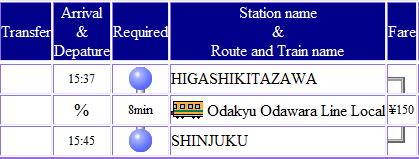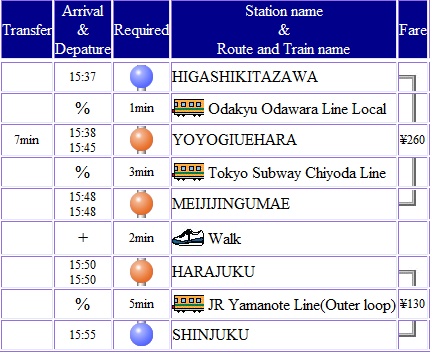

Today, I finally got two items I wanted to get for some time. A commuter pass and a PASMO.
I got a student commuter pass from Seijogakuenmae to Shinjuku, for the Odakyu line. This covers one half of the route to the Hongo campus I have to take three times a week, and it also covers the route to my lab (then I get off before Shinjuku, but that doesn't matter, it still works). Plus I can use it whenever I need to go to Shinjuku for something else (and since that's usually the first stop no matter where in Tokyo I want to go, that happens a lot). Despite the fact that most people told me I couldn't get a student pass as long as I was only a research student, I still managed to get one. Which is good, since it's a good deal cheaper than a regular commuter pass. I waited so long to get one because I wanted to at least try to get a student pass, so I had to wait until I had my student ID card.
I considered also getting a pass for the second part (from Shinjuku to Hongo-sanchome with the Oedo line), but I only do that three times per week, and there's far less chance of incidental trips that way than on the way to Shinjuku. The commuter pass would cost almost as much as the single tickets would, so I didn't do it. Plus this affords me the freedom of using alternative routes, such as the Chiyoda line, if I want to.
It should be clear from this little explanation that the biggest problem with Tokyo public transportation is all the different companies. You pretty much have to buy a ticket every time you transfer. So far I've been using a passnet pass, which is a magnetic ticket which you buy in advance. It's not any cheaper than individual tickets, but you buy a fixed amount in advance and can use the pass until it's empty (then you must buy a new one). Passnet works on Odakyu and most subway lines (including the Oedo and Chiyoda lines), so it was fairly convenient. It does not, however, work on the JR lines. JR uses a system called Suica, which is a rechargable IC card (chip card), but that doesn't work for anything besides JR (or at least it used to).
A few months ago they introduced the PASMO. It's a rechargable IC card which works on (afaik) every single train and subway company in Tokyo (even JR; the PASMO and Suica can be used interchangably) and even in most buses. Like Passnet it's not cheaper but it is considerably more convenient. What's more, you can also put a commuter pass onto a PASMO, so I can now use this one pass where ever I go in Tokyo, even for the commuter pass route!
I would've gotten a PASMO a great deal sooner, but the PASMO was far more successful than originally anticipated (apparently they sold over 3 million in the first month; they had predicted only 2 million). Because of this currently PASMO's can only be bought in combination with a commuter pass; "normal" PASMO sales have been halted. But now I have one, which will make things much easier. :)
PASMO official site (in English).
Path finding is a fairly simple problem with well-known algorithms. When you're doing path-finding for a train route this is even easier: all you have to consider is the price and duration of the different possibilities (as well as convenience factors such as number of transfers if you want a really good result).
The website Hyperdia offers a convenient way to find train routes in Japan. When I was looking for a route from Higashi-kitazawa (the station nearest to my lab at Tokyo University) to Shinjuku, it makes sense that it comes up with this route:

Note that I don't actually need Hyperdia to find this out; this route is simple and I've taken it many times (although usually not starting at Higashi-kitazawa but earlier down the line). I was mainly interested in the price from this station, and I wanted to see if it would be faster to walk to Yoyogi-Uehara instead and take an express train. But I digress.
Hyperdia always gives you several alternatives. Sometimes routes that are faster but more expensive, slower but cheaper, take more or less transfers, and, as I've found out today, sometimes it's routes that are slower, take more transfers, and are more expensive! This is the second option Hyperdia lists for this route:

Uhm, ok? I've plotted these two routes on a map. As you can see they appear very similar in terms of distance covered. But the second route takes two transfers instead of zero, is more than twice as expensive, takes almost twice as long, and includes two minutes walking!
Some consolation can be found in the fact that this was at least not the first route it offered, so it does at least recognize that the other one makes more sense. But the fact that this route is offered at all makes you wonder what kind of weird weight-function is used to evaluate these routes? :P
[The title of this post comes from the phrase "Rare jongens, die Romeinen", which is the Dutch version of Obelix's catch phrase "Ils sont fous ces romains" ("These Romans are crazy")]
Having been in Japan for slightly more than a month, I think it's time to reflect on some of the Japanese habits that struck me as strange. Now I'm aware that this has been done to death by pretty much everyone who's been in Japan for more than five minutes, but that's not going to stop me! I will make several posts on this subject, but I will make no guarantees as to when or how often these posts appear (because if I did, I'd probably not be able to keep to it anyway :P ).
The first thing I want to look at is theft, or actually the lack thereof. The Japanese seem to put an enormous amount of trust in their population, since security tends to minimal. I've heard it said that this is because the idea of stealing is so dishonouring that they wouldn't even consider it. Maybe it's because they make it so easy to do that any self-respecting criminal would be ashamed to do something with so little challenge attached.
For example, back in the Netherlands getting into my apartment building was a fairly involved procedure. You needed to use a keycard at the main door (twice, if it was after 23:00; once for the outer door and once for the inner door). The building had four main entrances, but the keycard only worked on the entrance you were supposed to use. Of course there was camera-surveilance too. Then there's the key for the hall containing your room (which can also be used for the mailbox), and finally the room key.
Here, there's no hall keys. No outer door keys. And while there is a guard at the main entrance, all the fire exits are kept open most of the day and may be used for entry without any kind of supervision. This means that if you feel like raiding one of the public areas, such as one of the kitchens, there's not really anything to stop you from doing it.
Stores are even more amazing. In the Netherlands, there are those electronic security devices attached to items. or in a supermarket the only way to leave is through the cash registers. Here, I've yet to see a store with any kind of anti-theft device. In the nearby Seiyu supermarket, because I use the side exit, I have to cross through the vegetable section, with my already purchased items, so it's not only possible to leave the supermarket without passing the registers, it's required.
My bike has a laughable excuse for a lock which would guarantee theft within minutes if this was used at a Dutch train station. But here it's common; I've yet to see the heavy chains that are common in the Netherlands.
Speaking of train stations... the Japanese use a system similar to the Paris subway: you have to use your ticket to get through gates at the entrance and exit (pretty much the only way, since Japanese trains tend to be so crowded you can't even move (and no, this is not an exaggeration), so it would certainly be impossible for someone to check the tickets on the train). In Paris, it is fairly impossible to pass these gates without a ticket. Here, it'd be fairly trivial (except for the enormous number of people who typically dwell at stations; while you could do it, it'd be hard to do unnoticed :P ).
And then there's the enormously crowded trains and stations. Which really is rediculous; for my Dutch readers, you might've been in a train that was so full the driver refused to leave. These are even more crowded than that. Whenever I'm boarding such a train, there's always the point where everyone is so squeezed together that I think it's not humanly possible to for anyone else to come on board and still close the doors. At that point, usually at least five more people manage to get in. The only consolation is that because I'm relatively tall, at least I can still breath.
But I digress. In most Western countries, such conditions would be a prime ground for pick-pockets. Here, it doesn't happen. You can just put your bag on the luggage rack and forget about it until you get out. There's no need to watch your belongings at all (it is then also not surprising that many Japanese tourists in Western countries get robbed quite easily; they're not used to having to watch out for there stuff).
Yes, I'm sure there are plenty of places in Tokyo where walking around at night is not safe, but overall Japan is living up to its reputation as one of the safest countries in the world. :)
I just had my very first earthquake (not just in Japan; the first earthquake of my entire life). I was at home, in my room, when I noticed the room shake. It was very weak, and lasted only a few seconds. In fact, it was so short that I wasn't sure if I'd imagined it or not.
But according to the Japanese Meteorological Agency, there was an earthquake at 21:01 JST, May 8th 2007. It had a magnitude of 4.4 on the Richter schale, but the epicentre was quite a bit away from here, which explains why I barely noticed it (and hardly anyone else here noticed it at all). The JMA uses a scale called the JMA Seismic Intensity Scale. By that scale, the quake was intensity 3 at the centre. According to their breakdown by location, the intensity in this area (Setagaya-ku) was only 1.
The JMA has information about the most recent quakes here. The information about this quake will be on there for about a week (it appears there has already been a more recent quake so this one is off the front page; you can find this one by clicking on of the buttons at the top and then selecting it from the list; that approach should work for a week, then it's gone).
UPDATE: MSNBC writes about the quake.
Pretty much from the moment I arrived in Japan I had to listen to friends and family on MSN and Skype saying what beautiful weather it was in the Netherlands, while at the same time it's been fairly hit and miss over here (a few nice days, a few very rainy ones too).
So to everyone who felt the need to remind me of that, I'd just like to say: nyah, nyah, serves you right. :P
